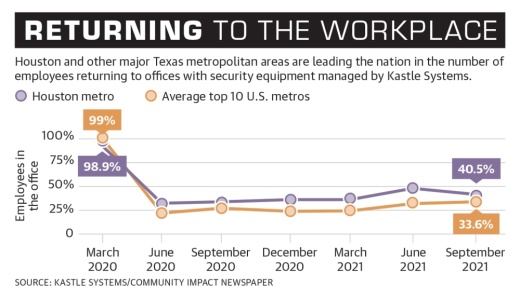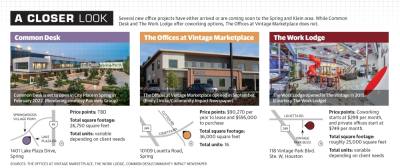As of Sept. 15, about 40.5% of employees in the Greater Houston area working at offices with security systems managed by Kastle Systems, which offers security services to more than 40,000 businesses nationwide, were scanning into the office.
Although that number is up from 33.4% in September 2020, it is down from 50.7% in July 2021. Mike Slauson, Kastle System’s Houston-based general manager, said lingering fears over the COVID-19 delta variant may continue to keep employees working from home.
"I think we would continue to see [the number of employees returning to work] rise, but now with this delta variant, we may see a pause,” he said.
In October 2020, more than 70% of the 5,858 U.S. adults who responded to a Pew Research Survey said they were performing their job remotely.
Brandon Bartkowiak, head of sales at Discounted Office Furniture Plus in Spring, said requests for home office furniture rose by nearly 30% in the initial months after COVID-19 restrictions were first imposed on businesses.
“Many people were not equipped, when COVID happened, to work from home,” he said, noting demand for home office equipment has remained high even as more employees return to the office.
While Houston’s office vacancy rate has risen since 2015, a number of new office projects are coming soon to both the city and local areas, such as Spring and Klein, although risks associated with COVID-19 have altered the way some developers view the traditional workplace.
Office vacancies
Houston’s office vacancy rate for the second quarter of 2021 was 24.4%, up from 22.3% at the same time in 2020, according to data provided by NAI Partners, a Texas-based real estate firm.
Patrick Duffy, president of real estate firm Colliers Houston, said Houston had the highest pre-pandemic office vacancy rate of any major U.S. city, largely due to an increase in construction to accommodate energy company expansions from 2010-14.
“Oil and gas crashed, and a lot of those plans were canceled,” he said, noting many leased properties were dumped into the sublease market. “We went from 1986 to 2002 in The Galleria without building a new building. I think we’re back in that kind of market for most areas.”
According to a July Colliers Houston office report, more than 3.5 million square feet of office space was under construction as of the second quarter of 2021—about 0.15% of the total office space in Houston.
Bobby Lieb, president and CEO of the Houston Northwest Chamber of Commerce, said most office space under construction in Houston that is scheduled to open this year is already 60% leased.
“[Developers] can come in and competitively price their new building and attract an existing company from one location to another within the Houston market,” Lieb said.
Lieb added a lot of the new office buildings coming into the market have been designed with open floor plans to create additional common space, which he said suits more modern work styles.
Robert Fields—president and CEO of national real estate firm Patrinely Group, which has developed commercial office buildings in City Place—said while he believes physical offices will remain a mainstay, employers will likely be more flexible in allowing for remote work in the future.
“When office development takes place going forward, I believe there will be a greater focus on flexibility, a greater focus on health and safety, and a greater focus on lifestyle,” Fields said.
Still, Fields said there are certain aspects of meeting in a physical office that are difficult to replicate when working remotely, including new-employee onboarding and team collaboration.
Lieb said while he believes most industries will eventually resume their operations in a physical office, certain sectors may extend remote working options for their employees.
“It’s going to be really dependent on the job itself,” Lieb said. “People are always thinking of new ways to maximize productivity, and if remote working does not do that, they’re going to call people back into the office.”
Finding solutions
Some developers have looked toward suburban markets, such as Spring and Klein, to build new office space. Although the office vacancy rate in the Spring and Klein area was 17.5% as of the second quarter of 2021, there was 568,000 square feet of office space under construction, according to data provided by Texas real estate firm Caldwell Cos.
The Offices at Vintage Marketplace—an office condominium project developed by Read King Commercial Real Estate—opened in September. The office complex boasts 16 2,250-square-foot units that businesses can purchase or lease.
Common Desk, which is set to open in February, will offer more than 26,000 square feet of office and coworking space in City Place. Dennis Tarro—executive managing director and principal of Patrinely Group, which will manage the property—said Common Desk will offer short-term leases to businesses of varying sizes.
“Tenants, even today with the emergence of the delta variant and future variants, are still hitting the pause button,” he said. “They’re really reticent to make a long-term commitment, so ... the first spaces being reactivated in the marketplace as the pandemic progresses are these coworking facilities.”
The Work Lodge, which opened in The Vintage in 2015, also offers flexible office space and coworking options that can be leased month to month. Owner Mike Thakur, who spent five years working from home, said he pursued the development because he could not find any affordable offices in the area tailored to smaller operations.
Thakur said while he believed some businesses could operate remotely, most would still perform better in an office setting.
“On the one hand it sounds great, being at home and working at home, but on the other hand, not having that human interaction and social interaction that we’re built for is taking a toll for sure,” Thakur said. “With remote working, it does not help with collaboration. It does not help with communication. ... That causes challenges.”







